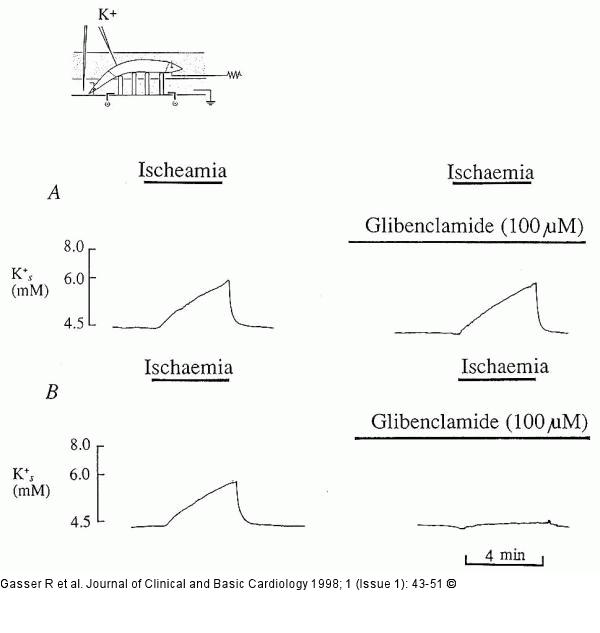Gasser R, Horn S, Köppel H Discrimination by valinomycin K-selective surface microelectrodes of a sulphonylurea-sensitive and a distinct sulphonylurea-, barium-, TEA- and cinnamate-insensitive component of K-efflux from isolated pig coronary arteries during simulated ischaemia Journal of Clinical and Basic Cardiology 1998; 1 (1): 43-51 PDF Summary Overview
| ||||||||||||||||
Figure/Graphic 3: K-Efflux in Koronararterien Guinea pig papillary muscle. Typical results when measuring K+ during an ischaemic episode. A. Experiment performed using an electrode bevelled with a 45° angle pushed too deeply into the preparation - penetrating approximately two or three layers of myocardial cells. Right handside panel: lack of effect of glibenclamide upon ischaemic K+ efflux in the same experiment, when microelectrode pushed too deeply into the tissue. B. Ideal experimental conditions: flat-tipped surface microelectrode gently touching the preparation like in Figure 2. Glibenclamide (100 microM) prevents early ischaemia-induced K+ efflux. |

Figure/Graphic 3: K-Efflux in Koronararterien
Guinea pig papillary muscle. Typical results when measuring K+ during an ischaemic episode. A. Experiment performed using an electrode bevelled with a 45° angle pushed too deeply into the preparation - penetrating approximately two or three layers of myocardial cells. Right handside panel: lack of effect of glibenclamide upon ischaemic K+ efflux in the same experiment, when microelectrode pushed too deeply into the tissue. B. Ideal experimental conditions: flat-tipped surface microelectrode gently touching the preparation like in Figure 2. Glibenclamide (100 microM) prevents early ischaemia-induced K+ efflux. |







